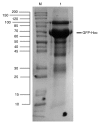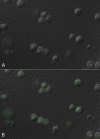Molecular imaging of T4 phage in mammalian tissues and cells - PubMed (original) (raw)
Molecular imaging of T4 phage in mammalian tissues and cells
Zuzanna Kaźmierczak et al. Bacteriophage. 2014.
Abstract
Advances in phage therapy encourage scientific interest in interactions of phages with human and animal organisms. This has created a need for developing tools that facilitate studies of phage circulation and deposition in tissues and cells. Here we propose a new green fluorescent protein (GFP)-based method for T4 phage molecular imaging in living systems. The method employs decoration of a phage capsid with GFP fused to the N-terminus of Hoc protein by in vivo phage display. Fluorescent phages were positively assessed as regards their applicability for detection inside living mammalian cells (by phagocytosis) and tissues (filtering and retention by lymph nodes and spleen). Molecular imaging provides innovative techniques that have brought substantial progress in life sciences. We propose it as a useful tool for studies of phage biology.
Keywords: T4 phage; green fluorescence protein; molecular imaging; phage circulation; phagocytosis.
Figures
Figure 1. Expression of recombinant GFP-Hoc fusion in E. coli. Expression plasmids containing GFP-hoc fusion were tested for their effectiveness in production of GFP-Hoc proteins as showed by SDS-PAGE. M, marker; 1, induced GFP-Hoc expressing bacteria.
Figure 2. Fluorescence of GFP-Hoc fusion in E. coli. Effective fluorescence of the GFP-Hoc fusion was assessed by comparison of fluorescence in E. coli induced for GFP-Hoc production and control E. coli (expressing protein Hoc without GFP).
Figure 3. Separation of modified bacteriophages by fast protein liquid chromatography. (A) Fraction containing bacteriophages. (B) Fraction containing non-incorporated GFP-Hoc fusions and other proteins.
Figure 4. Comparison of fluorescence in GFP-modified and control phage. Effective fluorescence of the purified GFP.Hoc.HAP1 phages was compared with the fluorescence of HAP1 phage (without GFP, purified identically by FPLC).
Figure 5. Visualization of GFP-modified bacteriophages in phagocytic cells J774A.1 (murine macrophages). Fluorescence of murine macrophage cell line was visualized in fluorescent microscopy. (A) control, phagocytes before incubation with GFP.Hoc.HAP1 phage, (B) phagocytes after 40 min incubation with GFP.Hoc.HAP1 phage.
Figure 6. Visualization of GFP-modified bacteriophages in murine tissues. GFP.Hoc.HAP1 phages and non-modified HAP1 phages (control) were injected into murine lateral tail vein (1011 pfu/mouse). Fluorescence of spleen and lymph nodes was visualized in an imaging hood. (A) spleen of mice injected with non-modified HAP1 phage, (B) spleen of mice injected with GFP.Hoc.HAP1 phage, (C) lymph node of mice injected with non-modified HAP1 phage, (D) lymph node of mice injected with GFP.Hoc.HAP1 phage.
Similar articles
- Circulation of Fluorescently Labelled Phage in a Murine Model.
Kaźmierczak Z, Majewska J, Milczarek M, Owczarek B, Dąbrowska K. Kaźmierczak Z, et al. Viruses. 2021 Feb 14;13(2):297. doi: 10.3390/v13020297. Viruses. 2021. PMID: 33672895 Free PMC article. - Portal fusion protein constraints on function in DNA packaging of bacteriophage T4.
Baumann RG, Mullaney J, Black LW. Baumann RG, et al. Mol Microbiol. 2006 Jul;61(1):16-32. doi: 10.1111/j.1365-2958.2006.05203.x. Mol Microbiol. 2006. PMID: 16824092 - Bacteriophage T4 nanoparticle capsid surface SOC and HOC bipartite display with enhanced classical swine fever virus immunogenicity: a powerful immunological approach.
Wu J, Tu C, Yu X, Zhang M, Zhang N, Zhao M, Nie W, Ren Z. Wu J, et al. J Virol Methods. 2007 Jan;139(1):50-60. doi: 10.1016/j.jviromet.2006.09.017. Epub 2006 Nov 1. J Virol Methods. 2007. PMID: 17081627 - Possible association between phages, Hoc protein, and the immune system.
Dabrowska K, Switała-Jeleń K, Opolski A, Górski A. Dabrowska K, et al. Arch Virol. 2006 Feb;151(2):209-15. doi: 10.1007/s00705-005-0641-7. Epub 2005 Sep 30. Arch Virol. 2006. PMID: 16195787 Review. - Mutations in bacteriophage T4 genome.
Switala-Jelen K, Dabrowska K, Gorski A, Sliwa L. Switala-Jelen K, et al. Acta Virol. 2002;46(2):57-62. Acta Virol. 2002. PMID: 12387495 Review.
Cited by
- Phage-Phagocyte Interactions and Their Implications for Phage Application as Therapeutics.
Jończyk-Matysiak E, Weber-Dąbrowska B, Owczarek B, Międzybrodzki R, Łusiak-Szelachowska M, Łodej N, Górski A. Jończyk-Matysiak E, et al. Viruses. 2017 Jun 14;9(6):150. doi: 10.3390/v9060150. Viruses. 2017. PMID: 28613272 Free PMC article. Review. - Biodistribution of Liposome-Encapsulated Bacteriophages and Their Transcytosis During Oral Phage Therapy.
Otero J, García-Rodríguez A, Cano-Sarabia M, Maspoch D, Marcos R, Cortés P, Llagostera M. Otero J, et al. Front Microbiol. 2019 Apr 4;10:689. doi: 10.3389/fmicb.2019.00689. eCollection 2019. Front Microbiol. 2019. PMID: 31019499 Free PMC article. - Recent trends in the use of bacteriophages as replacement of antimicrobials against food-animal pathogens.
Zia S, Alkheraije KA. Zia S, et al. Front Vet Sci. 2023 May 25;10:1162465. doi: 10.3389/fvets.2023.1162465. eCollection 2023. Front Vet Sci. 2023. PMID: 37303721 Free PMC article. Retracted. Review. - The Novel Role of Phage Particles in Chronic Liver Diseases.
Chen L, Hou X, Chu H. Chen L, et al. Microorganisms. 2023 Apr 30;11(5):1181. doi: 10.3390/microorganisms11051181. Microorganisms. 2023. PMID: 37317156 Free PMC article. Review. - Pharmacodynamic Evaluation of Phage Therapy in Ameliorating ETEC-Induced Diarrhea in Mice Models.
Xiong Y, Xia L, Zhang Y, Zhao G, Zhang S, Ma J, Cheng Y, Wang H, Sun J, Yan Y, Wang Z. Xiong Y, et al. Microorganisms. 2024 Dec 8;12(12):2532. doi: 10.3390/microorganisms12122532. Microorganisms. 2024. PMID: 39770735 Free PMC article.
References
- Górski A, Międzybrodzki R, Borysowski J, Dąbrowska K, Wierzbicki P, Ohams M, Korczak-Kowalska G, Olszowska-Zaremba N, Łusiak-Szelachowska M, Kłak M, et al. Phage as a modulator of immune responses: practical implications for phage therapy. Adv Virus Res. 2012;83:41–71. doi: 10.1016/B978-0-12-394438-2.00002-5. - DOI - PubMed
LinkOut - more resources
Full Text Sources
Other Literature Sources





